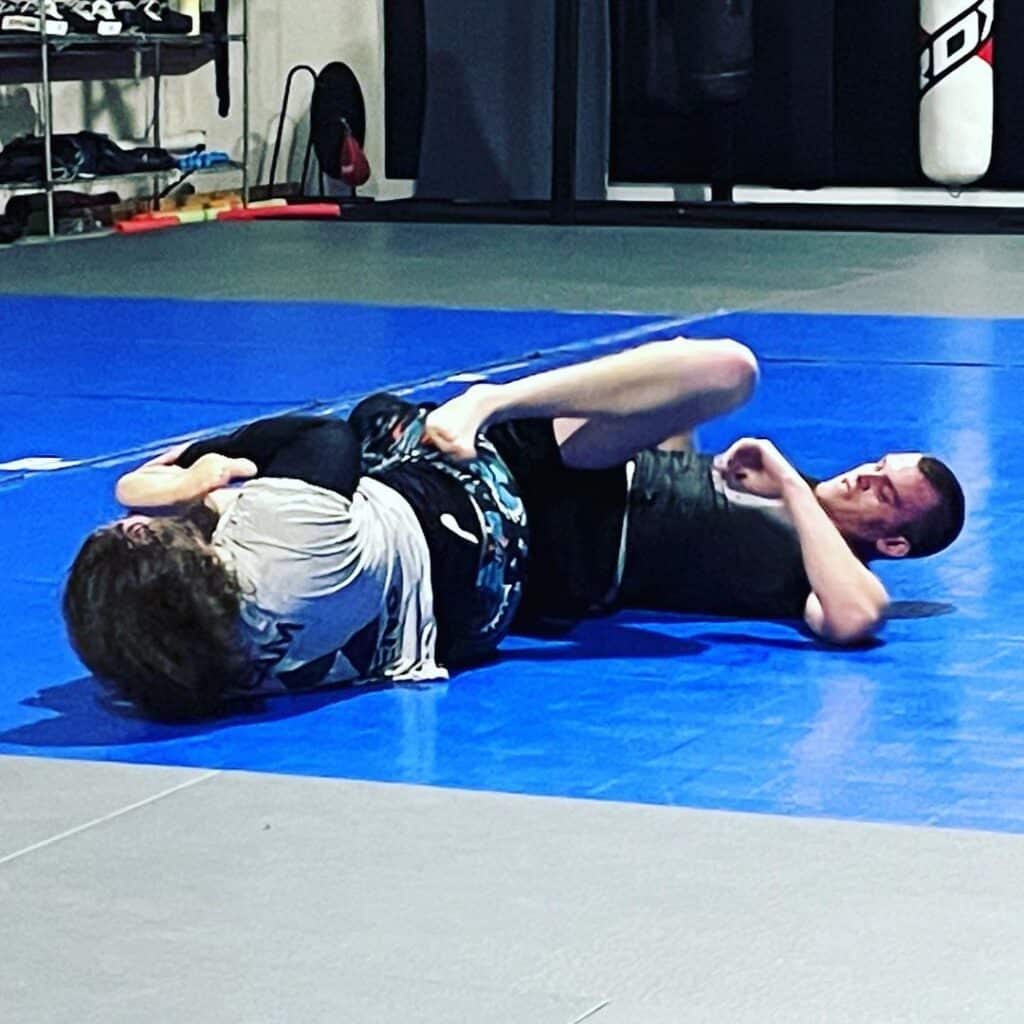Kneebar – BJJ Technique

There’s nothing quite like pulling off a good ole fashioned kneebar. It is one of the core leg lock submissions you need to know in order to have a complete Jiu Jitsu game.
Unfortunately if you compete in IBJJF ranking competitions, the kneebar is off limits until you become a brown belt or higher. But that shouldn’t stop you from practicing kneebar techniques.
The great thing about this submission is there are numerous entries from multiple guards and positions. Let’s get your kneebar right and tell you everything about this great leg attack. Everything from it’s creation, its mechanics, numerous entries, and tips for landing this submission.

When was the kneebar created?
The kneebar was a submission that Jiu Jitsu adopted from Judo, which judokus call the hiza-juji gatame. Although the grappling art that really elevated the submission was submission wrestling. Particularly the Russian grappling art of Sambo that focused more on leglocks than BJJ.
Sambo really puts an emphasis on leg locks like the kneebar, where in Jiu Jitsu it was avoided. Mostly due to the danger of severely damaging the opponent’s knee. Although in modern Jiu Jitsu, the kneebar is trained for frequently now and there are now numerous entries for it.
How does the kneebar work?
A kneebar works much in the same way an armbar works. You use leverage and pressure in the mechanics of this submission.
Once you establish control of the opponent’s hip, knee, and foot this makes their leg a lever. As you take an angle and bridge your hips into their leg this puts immense pressure on the opponent’s knee. If you have tight control of their knee with no space, they will have no other choice, but to submit.
Kneebar bottom half guard
When first learning the kneebar one of the easiest positions to do it from is bottom half guard. Particularly bottom half guard when you are using a knee shield.
This knee shield makes space between you and your opponent and gives you an easy path to their legs. With this technique, you’re going to hold your knee shield up on the opponent’s near shoulder.
Before you go for the opponent’s leg, you have to set it up. You just can’t try to grab their leg or they will immediately block you. To make the technique work, you have to make your opponent react.
In Gi, you’re going to use a collar grip with your knee shield. With No-Gi, you’re going to place your hand on the opponent’s far shoulder to keep them away.
You’re going to use these grips with your knee shield to push the opponent off base. Naturally they’ll react by basing and this will give you your entry to enter into your kneebar.
Hook under their leg and pull yourself to the opponent’s leg. Now you’re going to pendulum your hips to get momentum to bring your outside leg over the opponent’s body.
With your free hand grab the opponent’s to bring it towards you as you roll into position.
Remember your three points of control. Hips, above the knee, and the opponent’s foot. Without these three points of control the kneebar won’t work.
Curls your toes behind the opponent’s hips to establish control there, while squeezing your knees about their knee. Then cup their heel with one hand as you take an RNC grip and bring your head against their foot.
Bridge your hips like an armbar for the finish.
Kneebar top half guard
Getting a kneebar from top half guard is also really to pull off with only a few steps. If the opponent is on their side in half guard defending it gives you easy access for the kneebar.
You’ll still have to set up your kneebar entry and an easy way to do it is by attempting a kimura. When you go for a kimura, your opponent will immediately defend by getting on their side.
Once they get on their side all you do is bring your leg over their body and turn towards their leg. As you turn towards their leg, hook your legs behind the opponent’s hips and take an RNC grip on their foot.
From there just bridge your hips into their knee and finish your kneebar.
Rolling kneebar
A kneebar is such a versatile submission that you can set it up from standing. The rolling kneebar is quite an effective technique to learn.
From standing take an overhook on your opponent while having dominant head position under their chin. Naturally, they’ll fight to get head control and this is what you want for the set up.
Take wrist control and before you take your two steps before rolling towards their knee. Circle step to get the opponent around and then an instep to get into position for the roll.
As you roll, you’re going to go over your outside shoulder as you bring the opponent down with you. Hook your feet behind their leg, take your kneebar grip and bridge your hips to set in the pressure.
Back-step kneebar
The back-step kneebar is a good technique that comes from faking a knee slide pass. As you go to pass, the opponent will leave them open for a wide variety of counters including a kneebar.
Before you back-step, you have to sit down on their foot, because they could block it and take your back. With your weight on their leg, swing your leg over and hook your knee behind the opponent’s knee. This stops the opponent from escaping your leg lock.
From here all you do is grab their heel, pull the leg back, take a grip, and lock on the pressure.
50/50 kneebar
From the 50/50 position, the kneebar is a really good option you can go for. You start by standing up in 50/50 and grab their leg high with their foot under your armpit.
To get into position, you’re going to post as you turn your hips outwards and bring your knee to the ground.
With this kneebar, the opponent’s foot is going to be behind your foot. As you turn, there’s already pressure on their knee, so all you need to do is arch your back.
ADCC medalist Lachlan Giles shows both in this video.
Butterfly guard kneebar
Getting to a kneebar from the butterfly guard is also really easy to do. There’s only a few steps to get you into position for a really tight kneebar.
Start in butterfly guard and go 2 on 1 with an opponent’s arm. Push them and then pull them as you elevate the up with your butterfly hooks,
Pass their arm over and switch right into the ashi-garami position. Once you’re in ashi-garai, you go right to the kneebar.
Take their leg and pass it over your body and put their foot behind your armpit. From there, just cross your feet behind their hips and lock in the pressure.
Tips
The kneebar is similar to other leglocks in that you can’t leave out any steps when going for one. Any missed step and you will most likely not land this submission. Here are tips to remember.
- 3 points of control: Like with most every leg lock to do a good kneebar you need to have the 3 points of control. Have control of the hip, knee, and foot when you attempt a kneebar.
- Lock above the knee: The kneebar works just like an armbar, so you have your legs locked above their knee. If you lock below the opponent’s knee, there isn’t any pressure on their knee and they can escape easily.
- Heel control: With whatever grip you choose to go with remember to have it on the heel for control. It’s like wrist control with an armbar, where you need to establish control over it to pull off a successful kneebar.
- No space: You have to stay tight on your opponent’s leg and not give up any space. Any open space will give your opponent a way out of the submission.
- Curl your feet: To control the opponent’s hips remember to curl your feet next them.
- Kneebar grips: The kneebar grips you can do include an RNC grips, two hands cupping the heel, and behind your armpit.
- Head against their foot: Press your head against the opponent’s foot like you’re on the phone. This closes space and keeps them from being able to turn their foot.
- Thigh squeeze: Also like with an armbar, you have to squeeze the opponent’s leg with your thighs. This puts pressure on for the kneebar and keeps their leg in place.
- Hip bridge: For the finish of the kneebar, you have to bridge your hips into their leg to put on the pressure.






